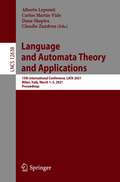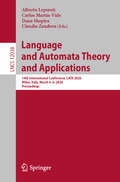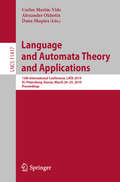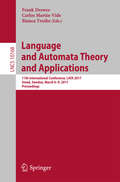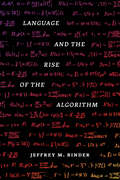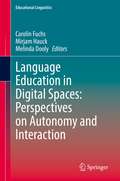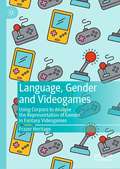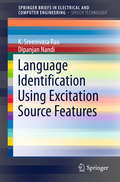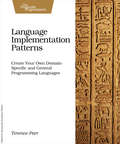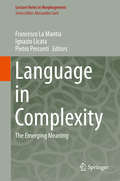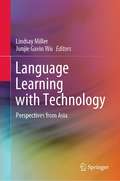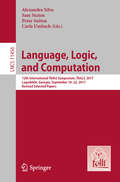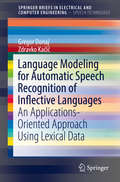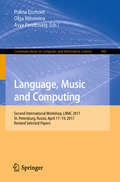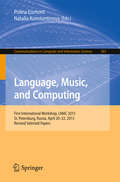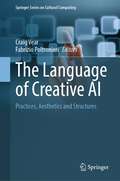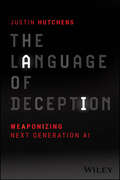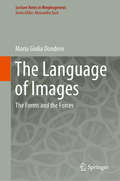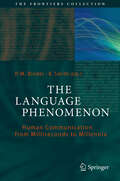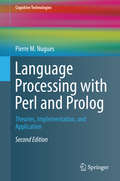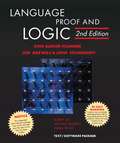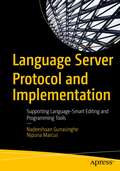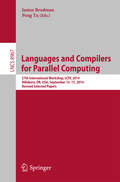- Table View
- List View
Language and Automata Theory and Applications: 15th International Conference, LATA 2021, Milan, Italy, March 1–5, 2021, Proceedings (Lecture Notes in Computer Science #12638)
by Alberto Leporati Carlos Martín-Vide Dana Shapira Claudio ZandronThis book constitutes the proceedings of the 15th International Conference on Language and Automata Theory and Applications, LATA 2021, held in Milan, Italy, in March 2021. The 26 full papers presented in this volume were carefully reviewed and selected from 52 submissions. They were organized in topical sections named: algebraic structures; automata; complexity; learning; logics and languages; trees and graphs; and words and strings.
Language and Automata Theory and Applications: 14th International Conference, LATA 2020, Milan, Italy, March 4–6, 2020, Proceedings (Lecture Notes in Computer Science #12038)
by Alberto Leporati Carlos Martín-Vide Dana Shapira Claudio ZandronThis book constitutes the proceedings of the 14th International Conference on Language and Automata Theory and Applications, LATA 2020, which was planned to be held in Milan, Italy, in March 2020. Due to the corona pandemic, the actual conference was postponed and will be held together with LATA 2021.The 26 full papers presented in this volume were carefully reviewed and selected from 59 submissions. They were organized in topical sections named: algebraic structures; automata; complexity; grammars; languages; trees and graphs; and words and codes. The book also contains 6 invited papers in full-paper length.
Language and Automata Theory and Applications: 13th International Conference, LATA 2019, St. Petersburg, Russia, March 26-29, 2019, Proceedings (Lecture Notes in Computer Science #11417)
by Carlos Martín-Vide Alexander Okhotin Dana ShapiraThis book constitutes the refereed proceedings of the 13th International Conference on Language and Automata Theory and Applications, LATA 2019, held in St. Petersburg, Russia, in March 2019. The 31 revised full papers presented together with 5 invited talks were carefully reviewed and selected from 98 submissions. The papers cover the following topics: Automata; Complexity; Grammars; Languages; Graphs, trees and rewriting; and Words and codes.
Language and Automata Theory and Applications
by Bianca Truthe Carlos Martín-Vide Frank DrewesThis book constitutes the refereed proceedings of the 9th International Conference on Language and Automata Theory and Applications, LATA 2015, held in Nice, France in March 2015. The 53 revised full papers presented together with 5 invited talks were carefully reviewed and selected from 115 submissions. The papers cover the following topics: algebraic language theory; algorithms for semi-structured data mining, algorithms on automata and words; automata and logic; automata for system analysis and program verification; automata networks, concurrency and Petri nets; automatic structures; cellular automata, codes, combinatorics on words; computational complexity; data and image compression; descriptional complexity; digital libraries and document engineering; foundations of finite state technology; foundations of XML; fuzzy and rough languages; grammatical inference and algorithmic learning; graphs and graph transformation; language varieties and semigroups; parallel and regulated rewriting; parsing; patterns; string and combinatorial issues in computational biology and bioinformatics; string processing algorithms; symbolic dynamics; term rewriting; transducers; trees, tree languages and tree automata; weighted automata.
Language and Complex Systems
by William A. Kretzschmar Jr.An understanding of language as a complex system helps us to think differently about linguistics, and helps us to address the impact of linguistic interaction. This book demonstrates how the science of complex systems changes every area of linguistics: how to make a grammar, how to think about the history of language, how language works in the brain, and how it works in social settings. Kretzschmar argues that to construct the best grammars of languages it is necessary to understand the complex system of speech. Each chapter makes specific recommendations for how linguists should manage empirical data in order to form better generalizations about a language and its varieties. The book will be welcomed by students and scholars working in linguistics and English language, especially the study of language variation and the historical development of English.
Language and the Rise of the Algorithm
by Jeffrey M. BinderA wide-ranging history of the algorithm. Bringing together the histories of mathematics, computer science, and linguistic thought, Language and the Rise of the Algorithm reveals how recent developments in artificial intelligence are reopening an issue that troubled mathematicians well before the computer age: How do you draw the line between computational rules and the complexities of making systems comprehensible to people? By attending to this question, we come to see that the modern idea of the algorithm is implicated in a long history of attempts to maintain a disciplinary boundary separating technical knowledge from the languages people speak day to day. Here Jeffrey M. Binder offers a compelling tour of four visions of universal computation that addressed this issue in very different ways: G. W. Leibniz’s calculus ratiocinator; a universal algebra scheme Nicolas de Condorcet designed during the French Revolution; George Boole’s nineteenth-century logic system; and the early programming language ALGOL, short for algorithmic language. These episodes show that symbolic computation has repeatedly become entangled in debates about the nature of communication. Machine learning, in its increasing dependence on words, erodes the line between technical and everyday language, revealing the urgent stakes underlying this boundary. The idea of the algorithm is a levee holding back the social complexity of language, and it is about to break. This book is about the flood that inspired its construction.
Language Education in Digital Spaces: Perspectives on Autonomy and Interaction (Educational Linguistics #52)
by Carolin Fuchs Mirjam Hauck Melinda DoolyThis book brings together contributions on learner autonomy from a myriad of contexts to advance our understanding of what autonomous language learning looks like with digital tools, and how this understanding is shaped by and can shape different socio-institutional, curricular, and instructional support. To this end, the individual contributions in the book highlight practice-oriented, empirically-based research on technology-mediated learner autonomy and its pedagogical implications. They address how technology can support learner autonomy as process by leveraging the affordances available in social media, virtual exchange, self-access, or learning in the wild (Hutchins, 1995). The rapid evolution and adoption of technology in all aspects of our lives has pushed issues related to learner and teacher autonomy centre stage in the language education landscape. This book tackles emergent challenges from different perspectives and diverse learning ecologies with a focus on social and educational (in)equality. Specifically, to this effect, the chapters consider digital affordances of virtual exchange, gaming, and apps in technology-mediated language learning and teaching ranging from instructed and semi-instructed to self-instructed contexts. The volume foregrounds the concepts of critical digital literacy and social justice in relation to language learner and teacher autonomy and illustrates how this approach may contribute to institutional objectives for equality, diversity and inclusion in higher education around the world and will be useful for researchers and teachers alike.
Language, Gender and Videogames: Using Corpora to Analyse the Representation of Gender in Fantasy Videogames
by Frazer HeritageThis book explores how corpus linguistic techniques can be applied to close analysis of videogames as a text, particularly examining how language is used to construct representations of gender in fantasy videogames. The author demonstrates a wide array of techniques which can be used to both build corpora of videogames and to analyse them, revealing broad patterns of representation within the genre, while also zooming in to focus on diachronic changes in the representation of gender within a best-selling videogame series and a Massively Multiplayer Online Role Playing Game (MMORPG). The book examines gender as a social variable, making use of corpus linguistic methods to demonstrate how the language used to depict gender is complex but often repeated. This book combines fields including language and gender studies, new media studies, ludolinguistics, and corpus linguistics, and it will be of interest to scholars in these and related disciplines.
Language Identification Using Excitation Source Features
by K. Sreenivasa Rao Dipanjan NandiThis book discusses the contribution of excitation source information in discriminating language. The authors focus on the excitation source component of speech for enhancement of language identification (LID) performance. Language specific features are extracted using two different modes: (i) Implicit processing of linear prediction (LP) residual and (ii) Explicit parameterization of linear prediction residual. The book discusses how in implicit processing approach, excitation source features are derived from LP residual, Hilbert envelope (magnitude) of LP residual and Phase of LP residual; and in explicit parameterization approach, LP residual signal is processed in spectral domain to extract the relevant language specific features. The authors further extract source features from these modes, which are combined for enhancing the performance of LID systems. The proposed excitation source features are also investigated for LID in background noisy environments. Each chapter of this book provides the motivation for exploring the specific feature for LID task, and subsequently discuss the methods to extract those features and finally suggest appropriate models to capture the language specific knowledge from the proposed features. Finally, the book discuss about various combinations of spectral and source features, and the desired models to enhance the performance of LID systems.
Language Implementation Patterns: Create Your Own Domain-Specific and General Programming Languages
by Terence ParrLearn to build configuration file readers, data readers, model-driven code generators, source-to-source translators, source analyzers, and interpreters. You don't need a background in computer science--ANTLR creator Terence Parr demystifies language implementation by breaking it down into the most common design patterns. Pattern by pattern, you'll learn the key skills you need to implement your own computer languages.Knowing how to create domain-specific languages (DSLs) can give you a huge productivity boost. Instead of writing code in a general-purpose programming language, you can first build a custom language tailored to make you efficient in a particular domain.The key is understanding the common patterns found across language implementations. Language Design Patterns identifies and condenses the most common design patterns, providing sample implementations of each.The pattern implementations use Java, but the patterns themselves are completely general. Some of the implementations use the well-known ANTLR parser generator, so readers will find this book an excellent source of ANTLR examples as well. But this book will benefit anyone interested in implementing languages, regardless of their tool of choice. Other language implementation books focus on compilers, which you rarely need in your daily life. Instead, Language Design Patterns shows you patterns you can use for all kinds of language applications.You'll learn to create configuration file readers, data readers, model-driven code generators, source-to-source translators, source analyzers, and interpreters. Each chapter groups related design patterns and, in each pattern, you'll get hands-on experience by building a complete sample implementation. By the time you finish the book, you'll know how to solve most common language implementation problems.
Language in Complexity
by Francesco La Mantia Ignazio Licata Pietro PercontiThis contributed volume explores the achievements gained and the remaining puzzling questions by applying dynamical systems theory to the linguistic inquiry. In particular, the book is divided into three parts, each one addressing one of the following topics: 1) Facing complexity in the right way: mathematics and complexity 2) Complexity and theory of language 3) From empirical observation to formal models: investigation of specific linguistic phenomena, like enunciation, deixis, or the meaning of the metaphorical phrases The application of complexity theory to describe cognitive phenomena is a recent and very promising trend in cognitive science. At the time when dynamical approaches triggered a paradigm shift in cognitive science some decade ago, the major topic of research were the challenges imposed by classical computational approaches dealing with the explanation of cognitive phenomena like consciousness, decision making and language. The target audience primarily comprises researchers and experts in the field but the book may also be beneficial for graduate and post-graduate students who want to enter the field.
Language Learning with Technology: Perspectives from Asia
by Lindsay Miller Junjie Gavin WuThis book is about language learning with technology, offering readers theoretical insights as well as practical case studies with a focus on Asia and Asian students. Although technology is rapidly advancing and most, if not all, students are already using technology in their everyday lives, traditional teaching/learning practices still exist throughout Asia. This book provides examples, written by representative educators, from a variety of countries/regions and contexts where technology has successfully been used to enhance language learning. In addition to some everyday examples of using technology: Wikipedia, PowerPoint, Google Docs and YouTube, the book also offers the readers an insight into the future possible uses of advanced technology: Augmented Reality, Virtual Reality, Artificial Intelligence and Eye Tracking. The book presents illustrations of how teachers can, and perhaps should, be open to integrating some form of technology into in-class learning or using it to supplement out-of-class activities.
Language, Logic, and Computation: 12th International Tbilisi Symposium, TbiLLC 2017, Lagodekhi, Georgia, September 18-22, 2017, Revised Selected Papers (Lecture Notes in Computer Science #11456)
by Peter Sutton Alexandra Silva Sam Staton Carla UmbachThis book constitutes the refereed proceedings of the 12th International Tbilisi Symposium on Logic, Language and Computation, TbiLLC 2017, held in Lagodekhi, Georgia, in September 2017.The volume contains 17 full revised papers presented at the conference from 22 submissions. The aim of this conference series is to bring together researchers from a wide variety of fields in Natural language syntax, Linguistic typology, Language evolution, Logics for artificial intelligence and much more.
Language Modeling for Automatic Speech Recognition of Inflective Languages
by Gregor Donaj Zdravko KačičThis book covers language modeling and automatic speech recognition for inflective languages (e. g. Slavic languages), which represent roughly half of the languages spoken in Europe. These languages do not perform as well as English in speech recognition systems and it is therefore harder to develop an application with sufficient quality for the end user. The authors describe the most important language features for the development of a speech recognition system. This is then presented through the analysis of errors in the system and the development of language models and their inclusion in speech recognition systems, which specifically address the errors that are relevant for targeted applications. The error analysis is done with regard to morphological characteristics of the word in the recognized sentences. The book is oriented towards speech recognition with large vocabularies and continuous and even spontaneous speech. Today such applications work with a rather small number of languages compared to the number of spoken languages.
Language, Music and Computing: Second International Workshop, Lmac 2017, St. Petersburg, Russia, April 17-19, 2017, Revised Selected Papers (Communications in Computer and Information Science #943)
by Polina Eismont Olga Mitrenina Asya Pereltsvaig<P><P>This book constitutes the proceedings of the First International Workshop on Language, Music and Computing, LMAC 2017, held in St. Petersburg, Russia, in April 2017. <P><P> The 18 papers presented in this volume were carefully reviewed and selected from 52 submissions. They were organized in topical sections on the universal grammar of music, the surface of music and singing, language as music, music computing, formalization of the informality.
Language, Music, and Computing
by Natalia Konstantinova Polina EismontThis bookconstitutes the proceedings of the First International Workshop on Language,Music and Computing, LMAC 2015, held in St. Petersburg, Russia, in April 2015. The 13papers presented in this volume were carefully reviewed and selected from 38 submissions. They were organized in topical sections on music and language in education; corpus studies of language and music; problemsof notation; and linguistic studies of music.
The Language of Creative AI: Practices, Aesthetics and Structures (Springer Series on Cultural Computing)
by Craig Vear Fabrizio PoltronieriCreative AI defines art and media practices that have AI embedded into the process of creation, but also encompass novel AI approaches in the realisation and experience of such work, e.g. robotic art, distributed AI artworks across locations, AI performers, artificial musicians, synthetic images generated by neural networks, AI authors and journalist bots.This book builds on the discourse of AI and creativity and extends the notion of embedded and co-operative creativity with intelligent software. It does so through a human-centred approach in which AI is empowered to make the human experience more creative. It presents ways-of-thinking and doing by the creators themselves so as to add to the ongoing discussion of AI and creativity at a time when the field needs to expand its thinking. This will avoid over-academization of this emerging field, and help counter engrained prejudice and bias. The Language of Creative AI contains technical descriptions, theoretical frameworks, philosophical concepts and practice-based case studies. It is a compendium of thinking around creative AI for technologists, human-computer interaction researchers and artists who are wishing to explore the creative potential of AI.
The Language of Deception: Weaponizing Next Generation AI
by Justin HutchensA penetrating look at the dark side of emerging AI technologies In The Language of Deception: Weaponizing Next Generation AI, artificial intelligence and cybersecurity veteran Justin Hutchens delivers an incisive and penetrating look at how contemporary and future AI can and will be weaponized for malicious and adversarial purposes. In the book, you will explore multiple foundational concepts to include the history of social engineering and social robotics, the psychology of deception, considerations of machine sentience and consciousness, and the history of how technology has been weaponized in the past. From these foundations, the author examines topics related to the emerging risks of advanced AI technologies, to include: The use of Large Language Models (LLMs) for social manipulation, disinformation, psychological operations, deception and fraud The implementation of LLMs to construct fully autonomous social engineering systems for targeted attacks or for mass manipulation at scale The technical use of LLMs and the underlying transformer architecture for use in technical weapons systems to include advanced next-generation malware, physical robotics, and even autonomous munition systems Speculative future risks such as the alignment problem, disembodiment attacks, and flash wars.Perfect for tech enthusiasts, cybersecurity specialists, and AI and machine learning professionals, The Language of Deception is an insightful and timely take on an increasingly essential subject.
The Language of Images: The Forms and the Forces (Lecture Notes in Morphogenesis)
by Maria Giulia DonderoThis book deals with two fundamental issues in the semiotics of the image. The first is the relationship between image and observer: how does one look at an image? To answer this question, this book sets out to transpose the theory of enunciation formulated in linguistics over to the visual field. It also aims to clarify the gains made in contemporary visual semiotics relative to the semiology of Roland Barthes and Emile Benveniste. The second issue addressed is the relation between the forces, forms and materiality of the images. How do different physical mediums (pictorial, photographic and digital) influence visual forms? How does materiality affect the generativity of forms? On the forces within the images, the book addresses the philosophical thought of Gilles Deleuze and René Thom as well as the experiment of Aby Warburg’s Atlas Mnemosyne. The theories discussed in the book are tested on a variety of corpora for analysis, including both paintings and photographs, taken from traditional as well as contemporary sources in a variety of social sectors (arts and sciences). Finally, semiotic methodology is contrasted with the computational analysis of large collections of images (Big Data), such as the “Media Visualization” analyses proposed by Lev Manovich and Cultural Analytics in the field of Computer Science to evaluate the impact of automatic analysis of visual forms on Digital Art History and more generally on the image sciences.
The Language Phenomenon
by K. Smith P. M. BinderThis volume contains a contemporary, integrated description of the processes of language. These range from fast scales (fractions of a second) to slow ones (over a million years). The contributors, all experts in their fields, address language in the brain, production of sentences and dialogues, language learning, transmission and evolutionary processes that happen over centuries or millenia, the relation between language and genes, the origins of language, self-organization, and language competition and death. The book as a whole will help to show how processes at different scales affect each other, thus presenting language as a dynamic, complex and profoundly human phenomenon.
Language Processing with Perl and Prolog
by Pierre M. NuguesThe areas of natural language processing and computational linguistics have continued to grow in recent years, driven by the demand to automatically process text and spoken data. With the processing power and techniques now available, research is scaling up from lab prototypes to real-world, proven applications. This book teaches the principles of natural language processing, first covering practical linguistics issues such as encoding and annotation schemes, defining words, tokens and parts of speech and morphology, as well as key concepts in machine learning, such as entropy, regression and classification, which are used throughout the book. It then details the language-processing functions involved, including part-of-speech tagging using rules and stochastic techniques, using Prolog to write phase-structure grammars, syntactic formalisms and parsing techniques, semantics, predicate logic and lexical semantics and analysis of discourse and applications in dialogue systems. A key feature of the book is the author's hands-on approach throughout, with sample code in Prolog and Perl, extensive exercises, and a detailed introduction to Prolog. The reader is supported with a companion website that contains teaching slides, programs and additional material. The second edition is a complete revision of the techniques exposed in the book to reflect advances in the field the author redesigned or updated all the chapters, added two new ones and considerably expanded the sections on machine-learning techniques.
Language, Proof and Logic 2nd Edition
by David Barker-Plummer Jon Barwise John EtchemendyThis book covers first-order language in a method appropriate for first and second courses in logic. It is designed to be used by undergraduates in philosophy, computer science, mathematics, and linguistics. Introductory material is presented in a systematic and accessible fashion. Advanced chapters include proofs of soundness and completeness for propositional and predicate logic, as well as an accessible sketch of Godel's first incompleteness theorem. The book is appropriate for a wide range of courses, from first logic courses for undergraduates (philosophy, mathematics, and computer science) to a first graduate logic course.
Language Server Protocol and Implementation: Supporting Language-Smart Editing and Programming Tools
by Nadeeshaan Gunasinghe Nipuna MarcusUnderstand the important aspects of implementing a production-grade language server in support of language-smart tools such as code editors and other programming utilities. This book shows you how to create a single implementation of a language server that can be used by multiple tools, enabling you to do the job once in a way that can be shared and reused. This book covers the language server protocol used for communication between programming tools and your language server. The book also provides an in-depth understanding of the design, implementation, and user experience aspects which should be considered when implementing a language server. The book walks you through an example language server implementation to illustrate the basic concepts, then goes on to cover advanced aspects of language server use such as progress reporting, launchers, and extension points. User experience is an important aspect of language server implementation and different tooling vendors strive to provide their own unique user experiences. This book explains how the protocol features can be leveraged to address the unique developer experience provided by different tooling vendors. The book also shows how to enhance the smoothness of the editing experience by orchestrating multiple features together.What You Will LearnImplement a language server from scratchUnderstand language server protocol and its data modelsLeverage the protocol while preserving the unique user experience of different editorsExtend the protocol to support more than its standard capabilitiesRun a language server on top of launchers such as standard I/O and TCP socketSeamlessly incorporate language semantics into your protocol featuresWho This Book Is ForDevelopers focused on and passionate about implementing language development tools such as plug-ins and extensions for interactive development environments (IDEs) or other tools that rely upon parsing of language statements and commands, and developers who need an in-depth understanding of the language server protocol as well as how to use the language server protocol to develop extensible language services
Language, Space and Mind
by Paul ChiltonThe idea that spatial cognition provides the foundation of linguistic meanings, even highly abstract meanings, has been put forward by a number of linguists in recent years. This book takes this proposal into new dimensions and develops a theoretical framework based on simple geometric principles. All speakers are conceptualisers who have a point of view both in a literal and in an abstract sense, choosing their perspective in space, time and the real world. The book examines the conceptualising properties of verbs, including tense, aspect, modality and transitivity, as well as the conceptual workings of grammatical constructions associated with counterfactuality, other minds and the expression of moral force. It makes links to the cognitive sciences throughout and concludes with a discussion of the relationship between language, brain and mind.
Languages and Compilers for Parallel Computing
by James Brodman Peng TuThis book constitutes the thoroughly refereed post-conference proceedings of the 27th International Workshop on Languages and Compilers for Parallel Computing, LCPC 2014, held in Hillsboro, OR, USA, in September 2014. The 25 revised full papers were carefully reviewed and selected from 39 submissions. The papers are organized in topical sections on accelerator programming; algorithms for parallelism; compilers; debugging; vectorization.
